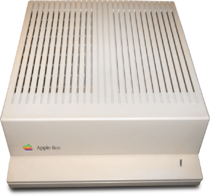Difference between revisions of "Apple IIGS emulators"
m (→Emulators) |
m |
||
| (One intermediate revision by one other user not shown) | |||
| Line 51: | Line 51: | ||
| {{✗}} | | {{✗}} | ||
|- | |- | ||
| − | | [ | + | | [https://www.sheppyware.net/software-mac/sweet16/ Sweet16] |
| align=left|{{Icon|macOS}} | | align=left|{{Icon|macOS}} | ||
| [https://www.sheppyware.net/software-mac/sweet16/ {{Sweet16Ver}}] | | [https://www.sheppyware.net/software-mac/sweet16/ {{Sweet16Ver}}] | ||
| Line 95: | Line 95: | ||
[[Category:Computers]] | [[Category:Computers]] | ||
| − | [[Category:Apple | + | [[Category:Apple computers]] |
Latest revision as of 08:02, 12 March 2024

| |
| An Apple IIGS PC. | |
| Developer | Apple Computer, Inc. |
|---|---|
| Type | Computers |
| Release date | September 1986 |
| Discontinued | December 1992 |
| Introductory price | $999 |
| Predecessor | Apple II |
| Emulated | ✓ |
The Apple IIGS is a 16-bit PC produced by Apple Computer, Inc. It was created to compete with the Amiga and the Atari ST lines of PCs.
Despite the Apple IIGS name, it is a completely different architecture. The system has a chip called the “Mega II” which is an Apple //e on a chip, making it fully backwards compatible with Apple ][ software.
It was the first machine from Apple to use the Apple Desktop Bus and the first to provide a colour version of QuickDraw since the first colour Macintosh was not available until 1987. However it does not provide a high-resolution square pixel mode.
Emulators[edit]
| Name | Platform(s) | Latest version | FLOSS | Active | Recommended | |
|---|---|---|---|---|---|---|
| PC / x86 | ||||||
| KEGS | 1.34 | ✓ | ✓ | ✓ | ||
| GSplus | 0.14 | ✓ | ✗ | ~ | ||
| GSport | 0.31 | ✓ | ✗ | ✗ | ||
| Sweet16 | 3.0.3 | ? | ✗ | ? | ||
| MAME | 0.265 | ✓ | ✓ | ✗ | ||
| Crossrunner | 1.02 | ? | ✓ | ? | ||
Processor[edit]
The central processor is a 65816, a backwards-compatible 16-bit update to the 6502 that was also used in the Super Nintendo. It runs natively at 2.8Mhz but will slow down to ~1Mhz when in classic Apple II emulation mode or when writing to video memory.
Graphics Capabilities[edit]
In addition to RGB emulations of the existing Apple II artefact composite video modes, the IIgs adds 320x200 and 640x200 RGB colour modes; the former in various combinations of 16 colours per line and the latter at 4 colours per line (including a hardware dithering mode that acts a little like 16 colours per line). Each line may use any of 16 palettes, making a total of 256 colours on screen without raster-linked palette changes.
There is also some support for 'fill mode', in which colour 0 means "repeat the last non-zero colour", designed to aid in fast single-colour fills.
Colours are selected from a 12-bit RGB 4,096 colour palette; the IIGS therefore has the same total colour range as its contemporaries the Commodore Amiga, the Atari STE and the Acorn Archimedes.
However it is subject to a number of deficiencies: there is a single buffer for video only — double buffering is not supported — and it supports neither hardware scrolling nor hardware sprites; and as all writes into video memory clock the CPU down to 1Mhz these are expensive to perform in software.
Audio Capabilities[edit]
The IIGS provides a 32-channel wavetable Ensoniq sound chip, which uses 64kb for samples.
The OS by default configures this as 15 stereo channels and uses the remaining two channels as interrupt counters; the IIGS is therefore often described as a 15-channel machine.
| Apple Inc. | |
|---|---|
| Desktop: Apple I • Apple II Line (Apple IIGS) • Apple III line • Lisa • Macintosh line • MacOS Mobile: iPod • iOS Consoles: Pippin |
